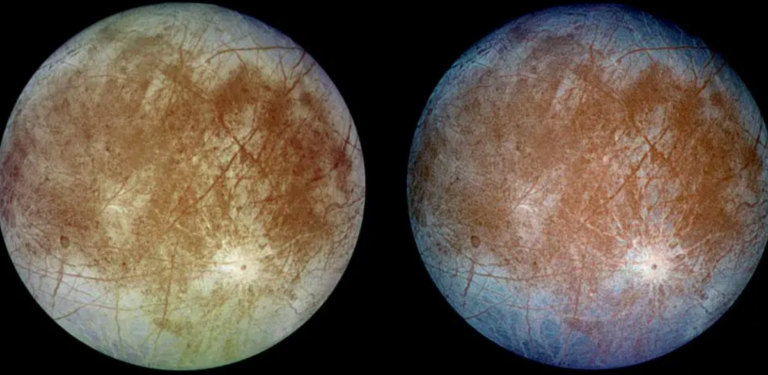Recent Juno images indicate that the icy crust of Europa is moving freely above its concealed ocean.
On September 29, 2022, NASA’s Juno spacecraft successfully conducted a flyby of Europa and was able to pass just 220 miles (355 kilometers) above the frozen surface of the moon. Higher resolution pictures taken by the spacecraft also provided details of Europa’s chaotic terrain which showed signs of slippage in the icy exterior. Among them was a strange element known as ‘Platypus’ because of its distinctive form.
More information about the SRU high-resolution images was published in the JGR Planets journal; the JunoCam images were valuable for the article published in the Planetary Science Journal.
NASA hypothesizes a salty ocean twice the size of all Earth’s oceans residing below Europa’s icy exterior. The moon has a rugged terrain with rugged dark features that may be evidence of water vapor escaping the moon into space.

Another striking image of Europa was taken during the close flyby by Juno’s SRU in black and white; the image shows a region of the surface with a network of fine grooves and double ridges. These long parallel line pairs denote high-relief features over an icy surface. The image is also characterized with the existence of intense radiation enclosing the moon and small white dots spread throughout the image which are actually high energy penetrating particles. Further, dark stains noticed in the surface could be connected with cryovolcanic plumes – liquid from under the ice gurgling up to the surface.
The Platypus, which can be seen in the bottom right corner of the picture, is also easy to distinguish as it is 42 miles (67 km) wide at its widest point. This distinctive feature is rough with prominent wrinkles and is made of a dark reddish brown material. The substance looks cluttered and has large pieces of ice of varying sizes from 0. 6 to 4. 1 to 7 km (3 miles).
The formation of ridges along the borders of the Platypus also helps to strengthen the idea that possible locations of briny water pockets from the subsurface ocean on the moon may collapse in the future due to the huge pressure from the icy mantle. Heidi Becker, the lead co-investigator for SRU at NASA’s Jet Propulsion Laboratory, clarified that these features are important for inferring current surface activity and putting constraints on the amount of subsurface liquid water on Europa.

The JunoCam visible light camera on board the spacecraft has effectively provided detailed images of the fractures, ridges and bands that cut across the surface of the moon. Such features seen in the photos offer critical information concerning Europa’s geology. Based on these surface features, NASA explains that they indicate that Europa’s outer ice shell is not firmly fixed to the interior of the moon, which is consistent with the theory of “true polar wander.
Juno co-investigator Candy Hansen says that stresses on the ice shell are high due to predictable fracture patterns. Notably, such fracture patterns have never been reported in the southern hemisphere of Europa, implying that TPW has wider influences on the surface geology of Europa than previously thought.
The JunoCam images have also contributed to a recent reconsideration of an interesting surface formation in Europa called Gwern. While initially assumed to be an impact crater, Gwern is an oval shadow created by the intersection of ridges.
NASA’s Juno mission that was launched in 2011 seeks to explore Jupiter and its planets. Among them, Europa has gained particular interest from scientists because it may potentially host life. More missions to study Europa are also being planned to learn more about the moon’s other distinctive features. NASA’s Europa Clipper mission, due to rendezvous Jupiter in 2030, will undertake magnetic field studies aimed at establishing whether Europa truly has an ocean beneath its icy exterior. For instance, the JUICE mission by the European Space Agency is on its way to the Jovian system to explore Jupiter and three of its oceanic-moon candidates.
Do not forget to share your opinion with us to provide you with the best posts !




0 Comments